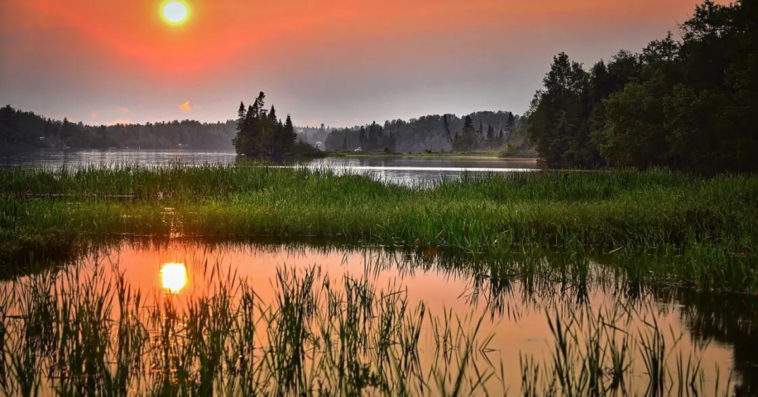Wetlands are shrinking. They are among the most economically and ecologically integral ecosystems but they are disappearing thrice as fast as forests.
I can no longer count how many crises the world has to face every single day. There will always be emerging ones after the other. It’s like an unending cycle which no definite solution and duration until when it will last. It can really be frustrating especially for those involved who are exerting an extra mile of effort just to put a stop to the crisis that they are facing. Apart from that, it can also be time-consuming, significantly if the crisis really impacts the livelihood of the people.
Ironically, the feeling of going through a crisis makes a person want to just shrink and get swallowed whole by the ground. The idea of wanting to just disappear and escape the problems at hand for the reason that it is beyond overwhelming. With that said, the irony of that sensation is also the global crisis that a part of Earth is currently experiencing – a tremor that one would fear.
Imagine losing your home – that hundred square meter place where you grew up and were fond of for years. Try envisioning what you would feel upon discovering that it will soon be gone and you will be left hanging by thread in finding solutions on how to avoid being homeless, worse, lose your livelihood.
Nightmare perhaps? Horrendous even? Nevertheless, the idea of losing a home is heartbreaking. What if I tell you that a part of the Earth is currently experiencing that? No, not just losing a wooden structure, but literally shrinking down – drowning even. Because yes, an environmental crisis on shrinking wetlands is at its peak.

See? There’s more than just a breakup crisis. People are actually and literally losing their homes due to natural causes. They are losing their livelihoods and this kind of crisis should be given adequate attention and support. But before going through the climax of this story, it is significant to define what wetlands are and just a little of its types for context and deeper substance for you to understand the nature of wetlands and why shrinking happens, including what we can do to avoid this from happening.
What are wetlands?

This has been taught to us way back in primary school as different kinds of lands and aquatic places were part of the discussion. However, we did not know that wetlands have several possible definitions.
According to The U.S. Fish and Wildlife Service, “Wetlands are lands transitional between terrestrial and aquatic systems where the water table is usually at or near the surface, or the land is covered by shallow water.
Wetlands must have one or more of the following three attributes: 1) at least periodically, the land supports predominantly hydrophytes; 2) the substrate is predominantly undrained hydric soil, and 3) the substrate is saturated with water or covered by shallow water at some time during the growing season of each year.”
Types of wetlands
Wetlands are known to go by different names such as swamps, marshes, potholes, bogs, etc. Technically, these are not wrong because they actually are wetlands. Apparently, wetlands are anywhere and can be caused by other matters, such as water coming from nearby rivers and seas that semi-flood an area.
According to National Geographic, “Wetlands exist in many kinds of climates, on every continent except Antarctica.” True enough, wetlands can neither be totally dry nor totally submerged underwater. With that said, as it varies in its size and types, some wetlands are surrounded by bountiful trees and some are similar to flatlands but more on the watery side.
Now along with these names, wetlands have three (3) major kinds that we all are familiar with. Remember that movie released back in 1999 where its main antagonist is crocodiles? Lake Placid! Right! The setting of the story was in a wetland and guess what? It was in a swamp. The next major kind of wetland is what we call marshes. ‘The Marshes’ in 2018 – a group of biologists found themselves in a remote marshland? The setting was in a marshland – marshes. And lastly, bogs (as in the place where mummies were found in Britain).
Swamps

A swamp is a wetland permanently saturated with water and dominated by trees. It could be as creepy as it is, but it can be an ideal place for a fine habitat (just watch out for potential predators though).
It has two types of swamps – freshwater and saltwater. Some swamps are The Eastern and Western Congolian Swamp Forests in the nation of the Democratic Republic of Congo and the Republic of Congo, Cypress Swamps, the bayous of the state of Louisiana, and The Sundarbans in India.
Marshes

Marshes are and can be formed by tides in lowlands that are near the coast. Oftentimes, it forms a watery grassland just near the riverbanks. Although, there are marshes that appear seasonally. (eg. when the water is high, it floods the grassland areas). Similar to swamps, marshes are also divided into salt and fresh water.
Australia has several saltwater marshes.
Bogs

Whilst marshes and swamps are commonly found in warmer areas, bogs are found in colder areas – the Arctic. They form in areas where the water table, or the upper surface of underground water, is high. They often begin in glacial depressions called kettle lakes, which are deeper than prairie potholes.
Basically, other plants and mosses growing along the edges of the lake form a loose, where eventually plants will grow for vegetation.
Why are wetlands important?
- They boosts the economy through its ecosystem as wetlands are one of the most productive ecosystems on Earth.
- Tourism – Most wetlands offer a picturesque scenery that it worth the time to visit and enjoy the serenity it has to offer.
- Source of freshwater – technically filters our water and provides us freshwater in exchange, which by the way the entire Earth depends on.
- Provides safe habitat especially for aquatic animals and plants that helps provide good benefits for the ecosystem.
Why are wetlands shrinking?
In the past decades and centuries, the population of humans and their environment grew largely. And as this continuously increases, various changes within the environment such as needs to survive and regulation of biodiversity were bound to happen one way or the other. Climate change, increased population, and urbanization are probable causes that are responsible for this crisis.
According to the United Nationals Climate Change Council, “The world’s remaining wetlands are under threat due to water drainage, pollution, unsustainable use, invasive species, disrupted flows from dams and sediment dumping from deforestation and soil erosion upstream.”
Thus, this boils down to the main culprits – humans. Regardless of our unconsciousness and illiteracy towards our environment, it is our due responsibility to remain oriented and educated with the planet that we are living on. Hence, it is safe to assume that not everyone knows this crisis.
Once again, this boils down to humans’ ignorance. With the lack of orientation, we might just be contributing worse effects to our ecosystem.
It is important to know that apart from the beauty and striking views wetlands could provide to feed our eyes, it plays a fundamental part in our natural system – from providing fresh water that is safe to drink, providing safe spaces for aquatic and land animals to grow, protect coastlines, mitigate floods, and basically helping protect the biodiversity from being disturbed.
These are all the benefits that the Earth is gaining from wetlands. However, it does not receive a deserving amount of attention – except for experts and concerned humans who care for it.
Effects of Shrinking Wetlands
Wetlands are also habitats that greatly contribute to the ecosystem. Once disturbed and damaged, our needs and natural resources will also be affected. And did you know that destruction of wetlands and the crisis of shrinking also open doors for other animals to go extinct? Yes, they might go extinct.
According to FLOW, “Wetlands destruction has increased flood and drought damage, nutrient runoff and water pollution, and shoreline erosion, and triggered a decline in wildlife populations.” And its degradation is rapidly occurring. Apparently, in the 1800s about 40% of Michigan’s wetland has been destroyed, and ever since it brought greater damage. On another note, apart from its great destruction of the natural system, the human economy is also at risk. Recreations such as fishing, hunting, and wildlife watching to progress and generate are at risk.
As observed, the degradation of wetlands, the environmental crisis of its shrinking, does not only affect the natural system, habitats of animals, and animals themselves. Because despite our ignorance and lack of education towards this stuff, it greatly affects us. Whether we like it or not, most of our freshwaters depend on wetlands. Without it, we would definitely find a hard time looking for ways to get fresh water. Sure, the technology era has already entered the party, but that does not guarantee a safe and better solution in solving our problems.




